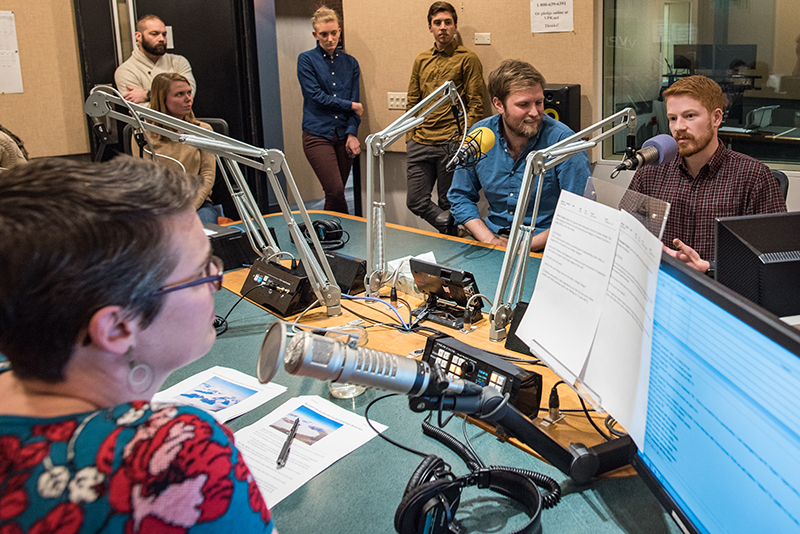To most people, the professional language of science is about as inviting as a pair of cement dancing shoes. It can be cold, opaque and downright bewildering. Got “in-situ cosmogenic nuclide exposure dating techniques?” But many of the greatest stories of our time lie hidden under this kind of jargon—moonshots, new vaccines, climate change solutions, how water striders do that thing.
“Helping young scientists become good storytellers should be part of their training,” says UVM geology professor Paul Bierman.
That’s why he’s leading nine graduate students into the studios of Vermont Public Radio on a gray winter’s day. They’re going to speak with two experts in finding and eliciting great stories: Jane Lindholm, the on-air host of Vermont Edition, and Ric Cengari, the show’s producer.
Cengari guides the students into the inner sanctum: the VPR production room. “This is our home,” Cengari says. There, the students watch three sound engineers working over a glowing panel of sliders and dials. Today, they’re trouble-shooting a slight echo Lindholm is hearing in her headphones, while—in the adjacent studio, separated by two thick panes of sound-proof glass—she interviews guests, live, for the daily noontime broadcast.
The show over—“We’re out,” says Cengari—the students are put in the hot-seat for an afternoon of real-world media training behind the microphone. The students have all sent in a one-page pitch of what they believe is interesting and urgent about their own research. The two veteran journalists use these to pepper each student with questions—recorded in a five-minute mock interview. “You’re passionate about this work. Now tell us why,” Cengari says, preparing the group. “Why should our listeners care?”
The students rise to the challenge. They talk—passionately—about the need people have for phosphorus; how new techniques for snow storage might save Vermont ski areas; how a bizarre material called a carbon nanotube could be used to make inexpensive water filters for people in the developing world; why travels to measure rock and ice in Antarctica can shed light on the fate of all coastal cities. (Hint: these measurements rely on “in-situ cosmogenic nuclide exposure dating techniques.”)
The students are enrolled in the course, “Critical Writing in Earth and Environmental Sciences,” and they’ve come from UVM’s College of Arts and Sciences, College of Engineering and Mathematical Sciences, Rubenstein School of Environment and Natural Resources, and Gund Institute for Environment. “Our primary focus is making your work accessible to others,” Bierman notes, and this trip to VPR’s studio is part of an expanded section in this year’s edition of the course to help these budding experts translate their scientific discoveries for non-experts. It’s part of a larger effort at UVM, with support from the National Science Foundation, to get the next generation of scientists ready not just to do research—but to tell the story of why their research matters.
“We were so impressed by the interest exhibited by all of the students, their research and their ability to explain it,” Cengari wrote in a follow-up email.
“That wasn’t just fun,” says doctoral student Kenna Rewcastle as she piles back into the van to return to campus. She had just explained to the journalists how the carbon now stored in bogs might become a dangerous contributor to climate change as these oxygen-starved wetlands dry out in a warmer world. “That was important.”
Source: UVM News

